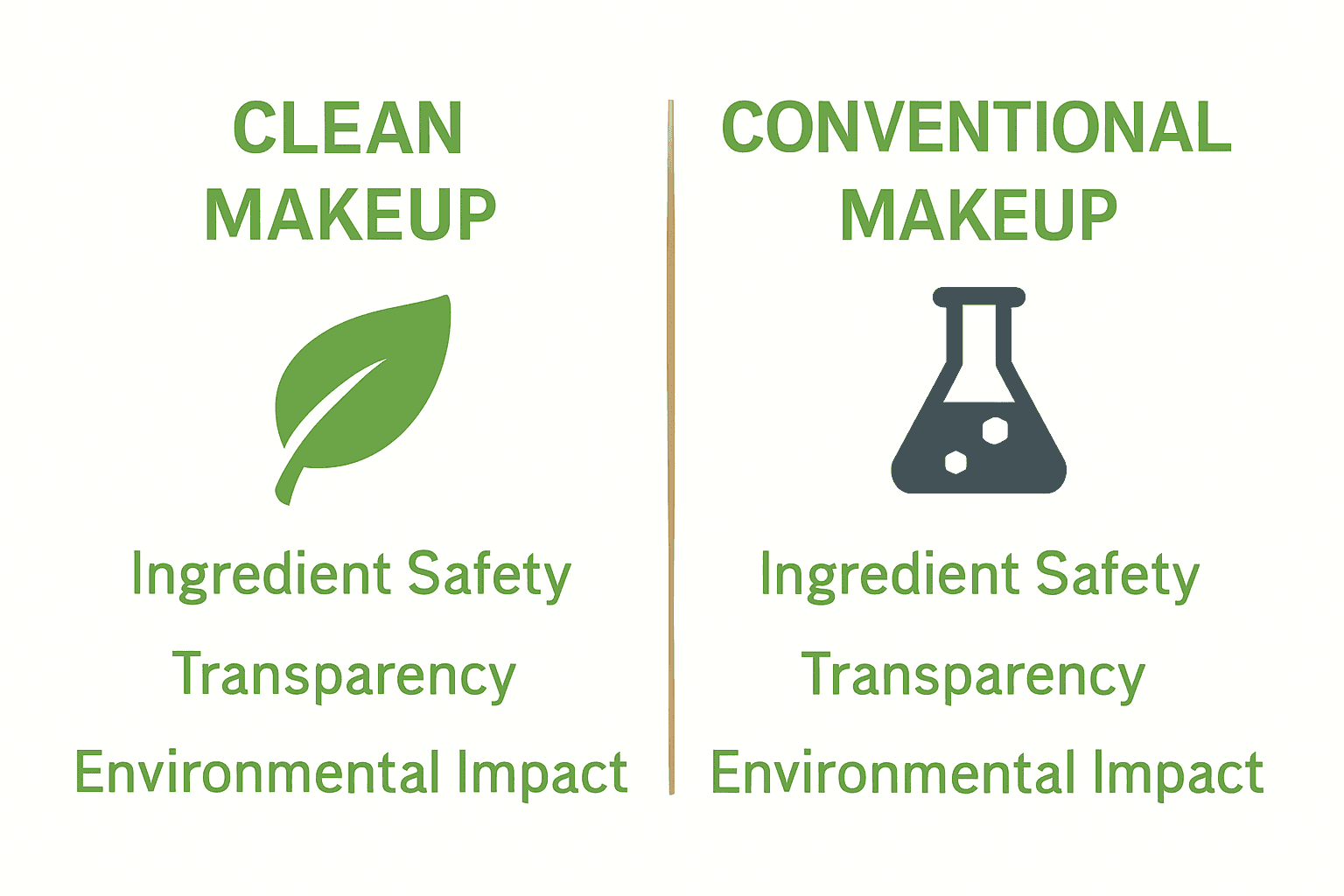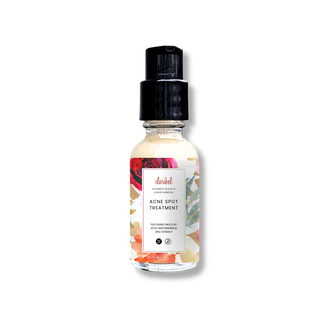Most american shoppers expect their makeup to be both safe and effective, yet over 70 percent of beauty ingredients on the market lack complete safety data. With growing concerns about toxins and hidden additives, choosing the right products can feel confusing. Understanding what clean makeup really means helps consumers avoid myths while making more informed choices that support health and wellness. This guide sheds light on the real standards and science behind clean beauty in the american market.
Table of Contents
- Defining Clean Makeup And Common Myths
- Key Ingredients And Formulation Standards
- Types Of Clean Makeup Products Available
- Benefits Of Switching To Clean Makeup
- Risks, Limitations, And Labeling Controversies
Key Takeaways
| Point | Details |
|---|---|
| Definition of Clean Makeup | Clean makeup prioritizes ingredient safety and transparency, focusing on natural and organic components while eliminating harmful synthetics. |
| Ingredient Selection | Key ingredients include natural botanical extracts and mineral-based pigments, emphasizing minimal processing and environmentally responsible sourcing. |
| Benefits of Clean Makeup | Transitioning to clean makeup can enhance skin health, reduce environmental impact, and promote ethical consumption through responsible brand practices. |
| Challenges in the Clean Makeup Movement | The industry faces risks such as regulatory ambiguity and greenwashing, requiring consumers to conduct thorough research beyond marketing claims. |
Defining Clean Makeup and Common Myths
Clean makeup represents a revolutionary approach to beauty products that prioritizes ingredient safety, transparency, and holistic wellness. According to the Know Better, Do Better Collaborative, this movement centers on a science-based definition focusing on comprehensive toxicological assessments to ensure both safety and efficacy in cosmetic formulations.
At its core, clean makeup goes beyond simply avoiding harmful chemicals. It represents a commitment to understanding what we apply to our skin, demanding rigorous ingredient screening and transparency from beauty brands. The key characteristics of clean makeup include:
- Elimination of potentially toxic synthetic chemicals
- Prioritization of natural and organic ingredients
- Comprehensive ingredient disclosure
- Minimal processing of raw materials
- Environmentally conscious production methods
However, misconceptions about clean makeup persist. Cosmopolitan highlights that many consumers misunderstand ingredient safety, particularly around sunscreen components. For instance, while mineral sunscreens are often perceived as universally safer, some chemical filters have actually been linked to potential hormone disruption and toxicity.
Understanding clean makeup requires moving beyond marketing buzzwords and developing a nuanced perspective on ingredient selection. It’s not just about eliminating “bad” ingredients, but intentionally choosing products that support skin health, environmental sustainability, and personal wellness. For more insights into this transformative approach, check out our Clean Beauty: Everything You Need to Know guide that delves deeper into the principles driving this revolutionary beauty movement.
Key Ingredients and Formulation Standards
Clean makeup formulation represents a sophisticated approach to beauty product development, prioritizing safety, efficacy, and transparency. Ingredient selection becomes a critical process where manufacturers meticulously evaluate each component’s potential impact on human health and environmental sustainability.
Key ingredients in clean makeup typically fall into several strategic categories:
- Natural botanical extracts
- Mineral-based pigments
- Plant-derived preservatives
- Non-toxic synthetic enhancers
- Organic stabilizing agents
According to International Standards Organization, cosmetic packaging and labeling play a crucial role in ensuring product safety and consumer information. The ISO 22715 guidelines provide comprehensive frameworks that help manufacturers maintain rigorous quality control and transparency in their formulation processes.
Beyond ingredient selection, clean makeup formulation standards emphasize minimal processing, environmentally responsible sourcing, and comprehensive ingredient disclosure. Brands committed to clean beauty must demonstrate a holistic approach that goes beyond merely avoiding harmful chemicals. This means prioritizing ingredients that not only prevent potential harm but actively support skin health and wellness. To explore more about ingredient selection strategies, check out our guide to active skincare ingredients for women that provides deeper insights into creating effective, safe cosmetic formulations.
Types of Clean Makeup Products Available
Clean makeup has evolved dramatically, offering consumers a diverse range of products that prioritize both performance and wellness. Cosmopolitan’s 2025 Clean Beauty Awards highlight the expanding landscape of clean makeup, showcasing innovative products across multiple cosmetic categories that are formulated without harmful chemicals and emphasizing natural ingredients.
The primary categories of clean makeup products include:
- Foundations: Lightweight, breathable formulations with mineral and plant-based pigments
- Lipsticks: Naturally derived color palettes with nourishing botanical ingredients
- Mascaras: Gentle, non-toxic eye makeup using plant-based polymers
- Concealers: Skin-healing formulations with organic botanical extracts
- Blushes and Bronzers: Mineral-based color products with sustainable ingredients
According to TC Chems, technological innovations in 2025 have dramatically transformed clean makeup development. AI-driven formulations and sustainable raw materials are expanding both the variety and efficacy of available options, allowing consumers unprecedented choice in clean beauty products.
When exploring clean makeup, it’s crucial to understand that product diversity goes beyond traditional cosmetic boundaries. Modern clean makeup represents a holistic approach to beauty that considers skin health, environmental impact, and personal wellness. For those interested in exploring the nuanced world of ethical beauty options, our Vegan Makeup guide offers comprehensive insights into selecting products that align with personal and planetary well-being.
Benefits of Switching to Clean Makeup
Switching to clean makeup represents more than a trend - it’s a transformative approach to personal health and environmental consciousness. Cosmopolitan reports that consumers are experiencing remarkable improvements in skin condition, with reduced irritation directly attributed to the absence of harsh chemicals and the strategic inclusion of skin-friendly, natural ingredients.
The primary benefits of transitioning to clean makeup include:
- Skin Health: Minimized exposure to potentially harmful synthetic chemicals
- Environmental Impact: Reduced ecological footprint through sustainable ingredient sourcing
- Holistic Wellness: Supporting body health through carefully selected natural components
- Long-Term Skin Protection: Preventing potential long-term damage from toxic ingredients
- Ethical Consumption: Supporting brands committed to transparent, responsible production
Modern clean makeup goes beyond surface-level beauty, offering a comprehensive approach to personal care that considers both individual and planetary well-being.
 The ingredients are carefully selected to not just cover or enhance, but to actively nourish and protect the skin.
The ingredients are carefully selected to not just cover or enhance, but to actively nourish and protect the skin.
 This means each application becomes an opportunity for skin restoration and wellness.
This means each application becomes an opportunity for skin restoration and wellness.
For those ready to dive deeper into the world of conscious beauty choices, our guide on clean ingredient skincare provides comprehensive insights into making informed, health-conscious cosmetic decisions that align with personal and environmental values.
Risks, Limitations, and Labeling Controversies
The clean makeup movement, while promising, is not without significant challenges. Cosmetics Design reports ongoing difficulties in the industry, highlighting persistent challenges in standardizing definitions and ensuring comprehensive ingredient safety, which ultimately leads to consumer confusion and growing skepticism.
Key risks and limitations in the clean makeup landscape include:
- Regulatory Ambiguity: Lack of universal ‘clean’ makeup standards
- Greenwashing: Brands making misleading environmental claims
- Limited Scientific Validation: Insufficient long-term research on alternative ingredients
- Cost Barriers: Higher prices compared to conventional makeup products
- Performance Inconsistencies: Variable efficacy across natural formulations
According to International Standards Organization, cosmetic labeling standards reveal complex international regulatory variations. The absence of a unified definition for ‘clean’ makeup creates significant industry challenges, leaving consumers navigating a landscape of conflicting claims and interpretations.
To make informed decisions, consumers must develop critical thinking skills and conduct thorough research beyond marketing claims. For comprehensive insights into navigating these complexities, our guide on non-toxic skincare offers valuable strategies for understanding and selecting truly responsible beauty products.
Discover Truly Clean Makeup Solutions You Can Trust
Navigating the confusing world of clean makeup can feel overwhelming with so many unclear definitions and hidden toxic ingredients. This article highlights the challenges of greenwashing and uncertain labeling, making it critical to choose beauty products that are genuinely safe, transparent, and effective. If you want to protect your skin from harmful chemicals while embracing natural, skin-loving ingredients, finding a trusted source is essential.
Our collection of Natural Cleansers is thoughtfully crafted with active ingredients you can rely on, without fillers or toxins.

Start your clean beauty journey today by exploring our carefully selected vegan, cruelty-free products designed to nourish your skin and promote wellness. Everything ships for free in the US. Visit ClaribelSkincare.com now to experience the transformative benefits of truly clean makeup and skincare.
Frequently Asked Questions
What is clean makeup?
Clean makeup refers to beauty products that prioritize ingredient safety, transparency, and holistic wellness. It focuses on eliminating potentially toxic synthetic chemicals and choosing natural and organic ingredients to support skin health and environmental sustainability.
What are the key benefits of switching to clean makeup?
Switching to clean makeup can enhance skin health, reduce exposure to harmful chemicals, minimize environmental impact, and promote holistic wellness. It offers long-term skin protection and supports ethical consumption by favoring brands that prioritize transparency and responsible production.
How do I identify clean makeup products?
Identifying clean makeup products involves looking for comprehensive ingredient disclosures, minimal processing, and a commitment to sustainable sourcing. Consumers should be aware of regulatory standards and be cautious of greenwashing claims made by brands.
What types of clean makeup products are available?
Clean makeup products come in various categories, including foundations, lipsticks, mascaras, concealers, blushes, and bronzers. These products often feature natural pigments and nourishing botanical ingredients, ensuring they prioritize both performance and skin health.



